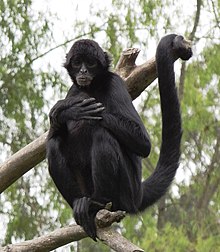| Spider monkey[1] | |
|---|---|

| |
| Black-headed spider monkey (Ateles fusciceps) | |
| Scientific classification | |
| Domain: | Eukaryota |
| Kingdom: | Animalia |
| Phylum: | Chordata |
| Class: | Mammalia |
| Order: | Primates |
| Suborder: | Haplorhini |
| Infraorder: | Simiiformes |
| Family: | Atelidae |
| Subfamily: | Atelinae |
| Genus: | Ateles É. Geoffroy, 1806 |
| Type species | |
| Simia paniscus | |
| Species | |
|
See text | |

| |
| Range of the spider monkeys | |
Spider monkeys are New World monkeys belonging to the genus Ateles, part of the subfamily Atelinae, family Atelidae. Like other atelines, they are found in tropical forests of Central and South America, from southern Mexico to Brazil. The genus consists of seven species, all of which are under threat; the brown spider monkey is critically endangered. They are also notable for their ability to be easily bred in captivity.
Disproportionately long limbs and long prehensile tails make them one of the largest New World monkeys and give rise to their common name. Spider monkeys live in the upper layers of the rainforest and forage in the high canopy, from 25 to 30 m (82 to 98 ft).[2] They primarily eat fruits, but will also occasionally consume leaves, flowers, and insects.[2] Due to their large size, spider monkeys require large tracts of moist evergreen forests, and prefer undisturbed primary rainforest.[2] They are social animals and live in bands of up to 35 individuals, but will split up to forage during the day.[3]
Recent meta-analyses on primate cognition studies indicated spider monkeys are the most intelligent New World monkeys.[4] They can produce a wide range of sounds and will "bark" when threatened; other vocalisations include a whinny similar to a horse and prolonged screams.[3]
They are an important food source due to their large size, so are widely hunted by local human populations; they are also threatened by habitat destruction due to logging and land clearing.[3] Spider monkeys are susceptible to malaria and are used in laboratory studies of the disease.[3] The population trend for spider monkeys is decreasing; the IUCN Red List lists one species as vulnerable, five species as endangered and one species as critically endangered.
- ^ Cite error: The named reference
msw3was invoked but never defined (see the help page). - ^ a b c Cawthon Lang, K.A. (April 10, 2007). "Primate factsheets: black spider monkey (Ateles fusciceps) taxonomy, morphology, and ecology". Wisconsin Primate Research Center (WPRC). Archived from the original on August 7, 2020. Retrieved May 20, 2009.
- ^ a b c d "Spider monkey". Encyclopædia Britannica Online. Encyclopædia Britannica, Inc. 2009. Archived from the original on September 4, 2009. Retrieved May 20, 2009.
- ^ Deaner, R.O.; van Schaik, C.P. & Johnson, V.E. (2006). "Do some taxa have better domain-general cognition than others? A meta-analysis". Evolutionary Psychology. 4: 149–196. doi:10.1177/147470490600400114. S2CID 16702785.